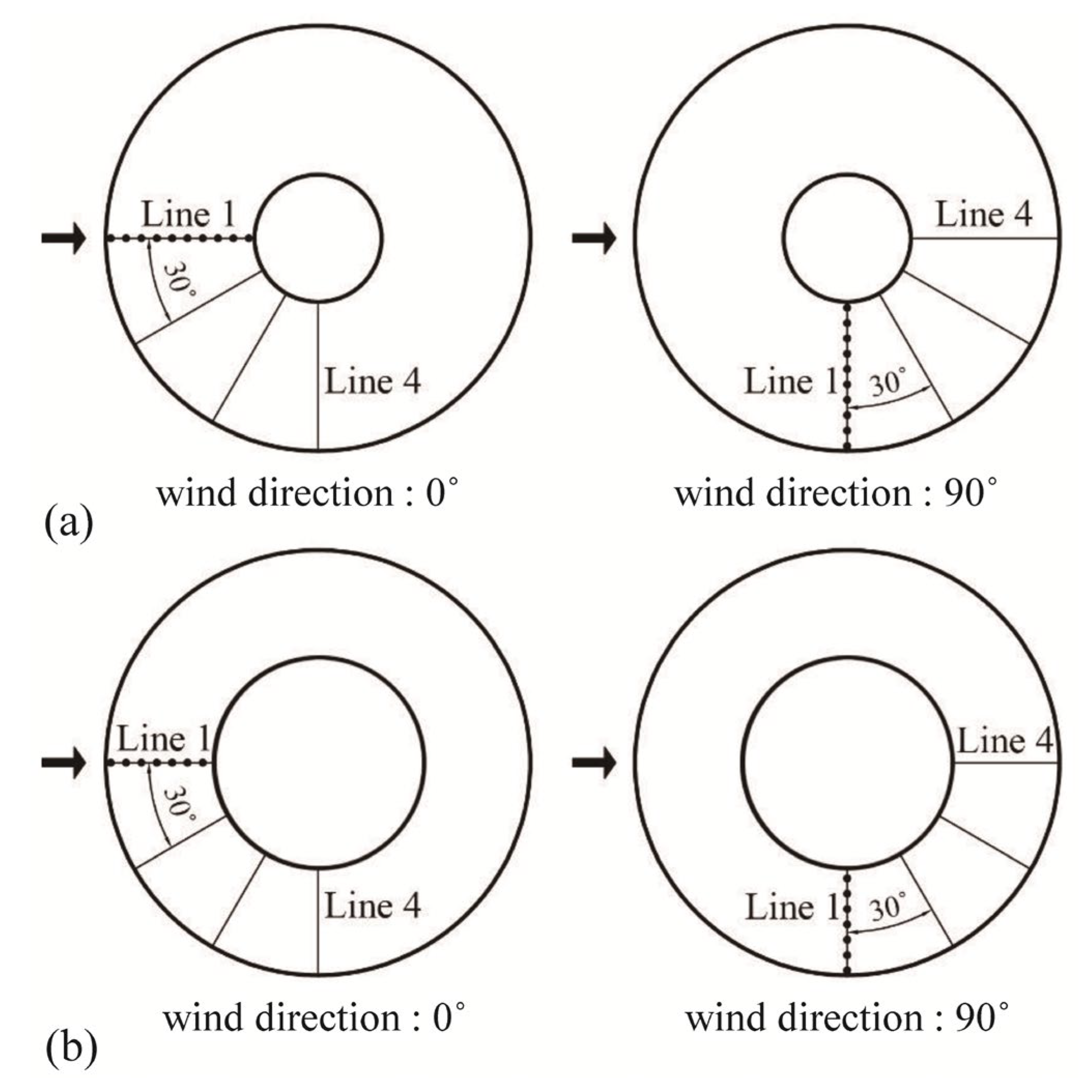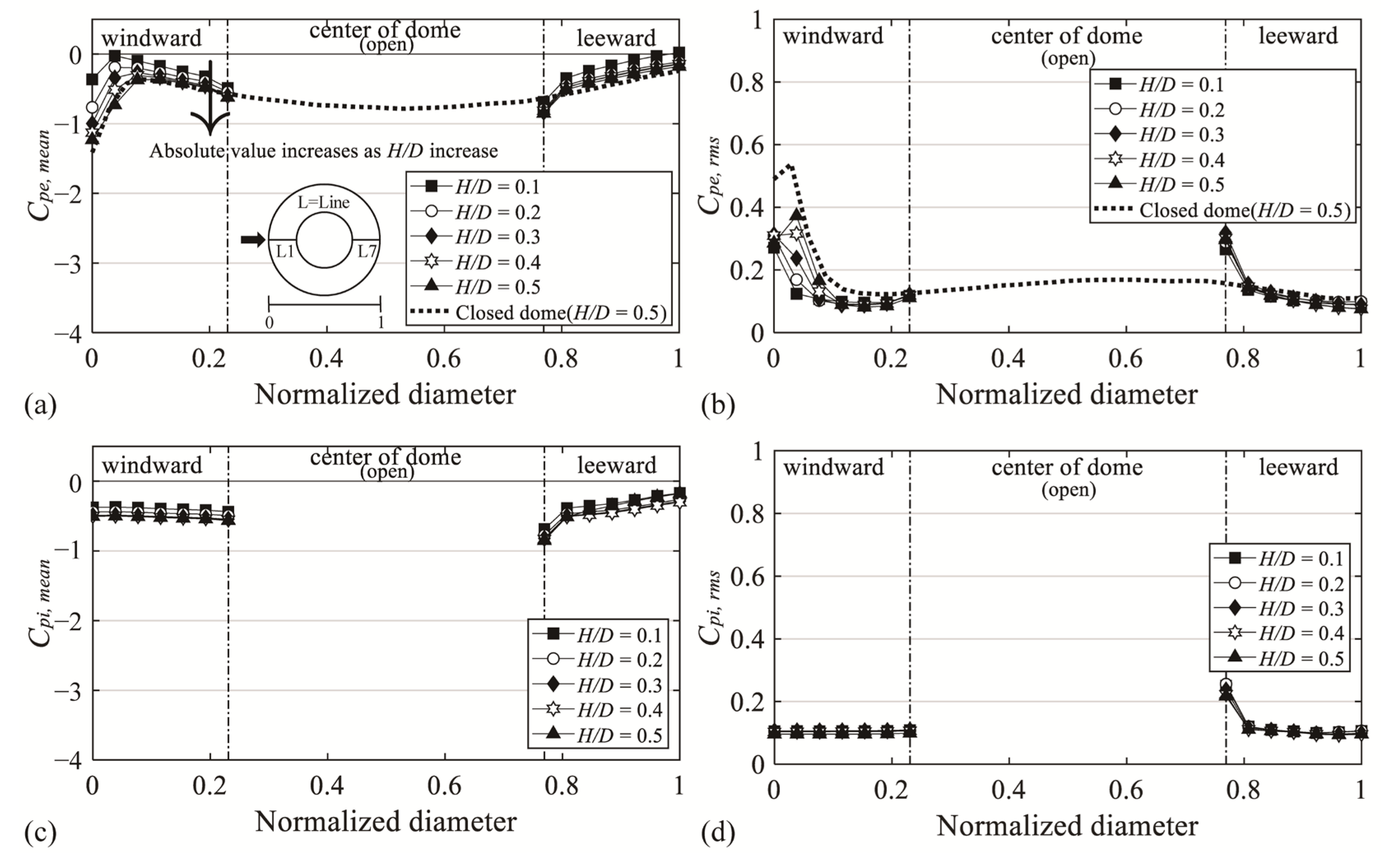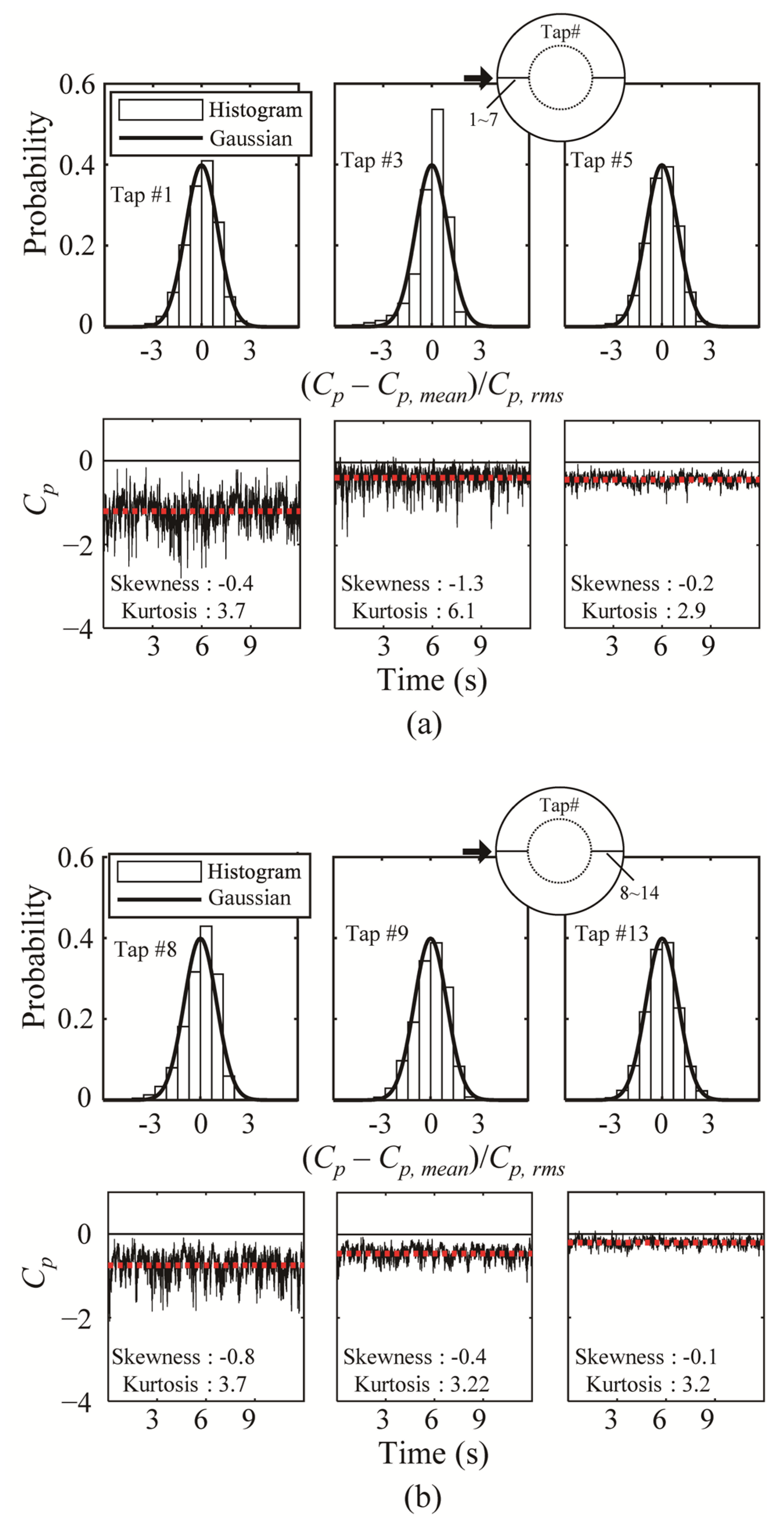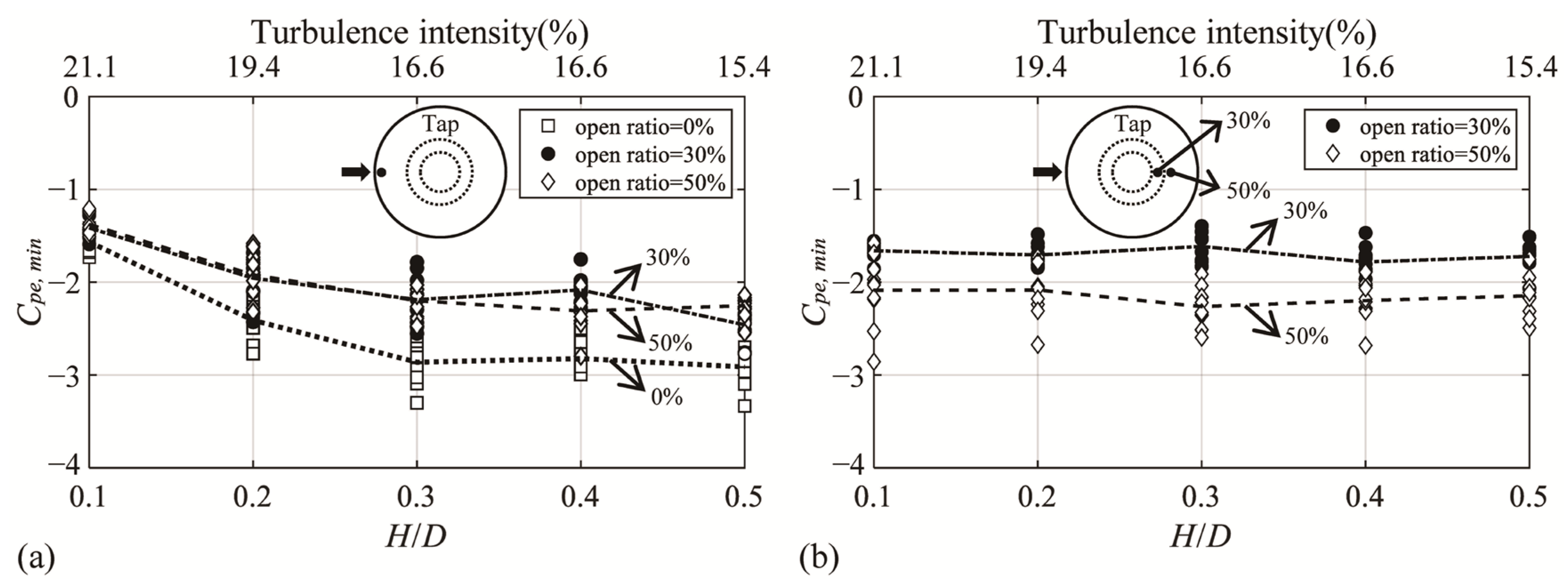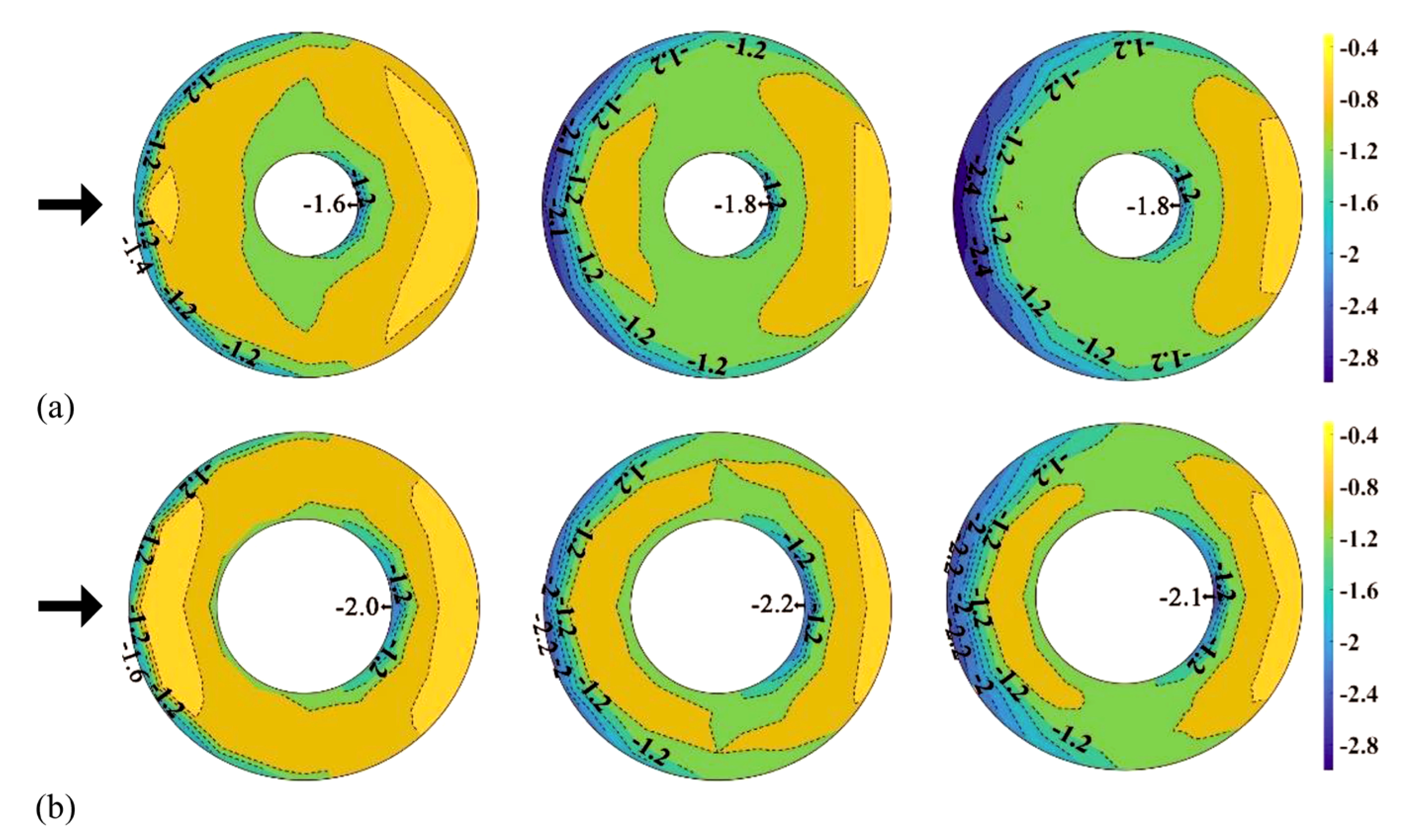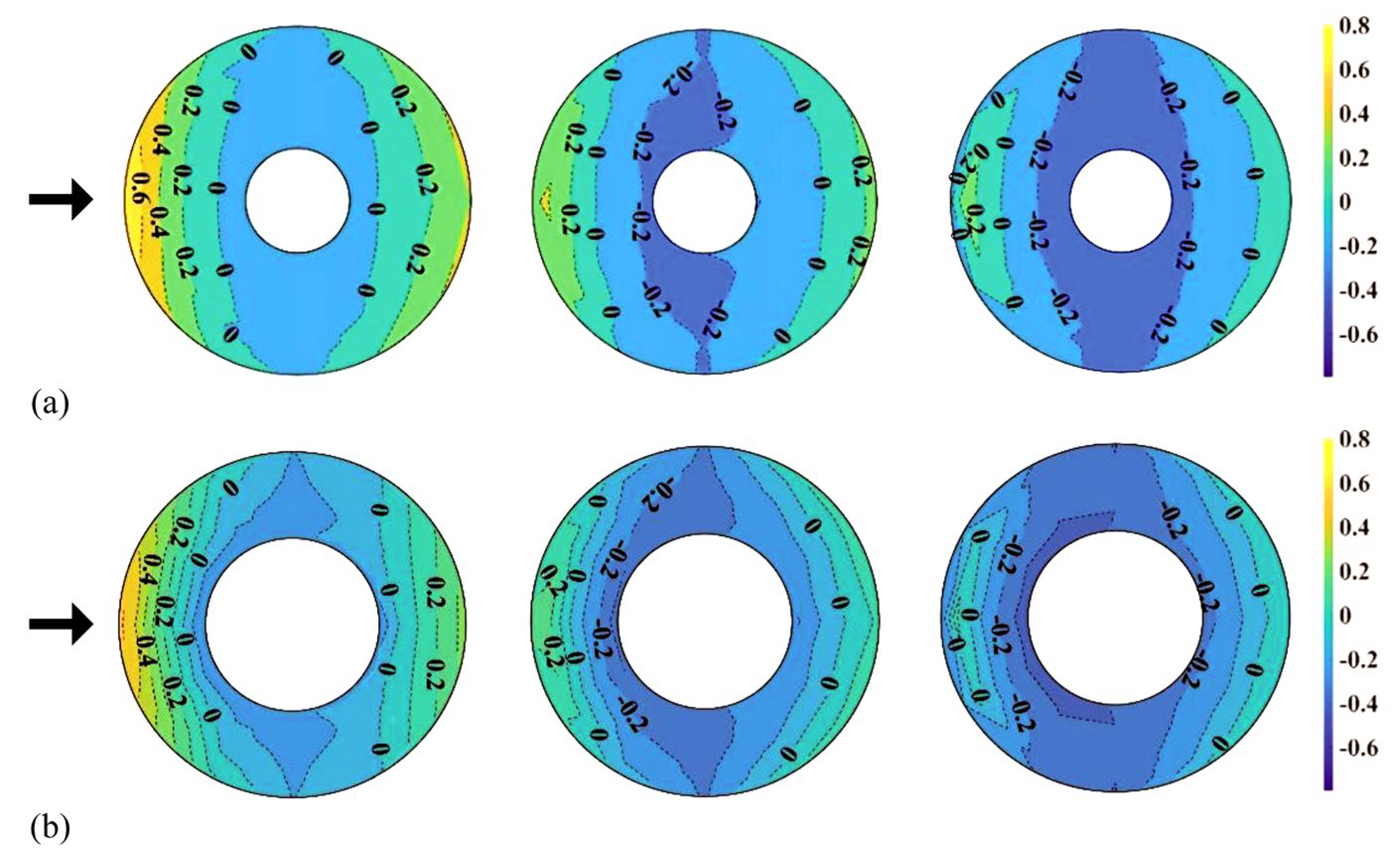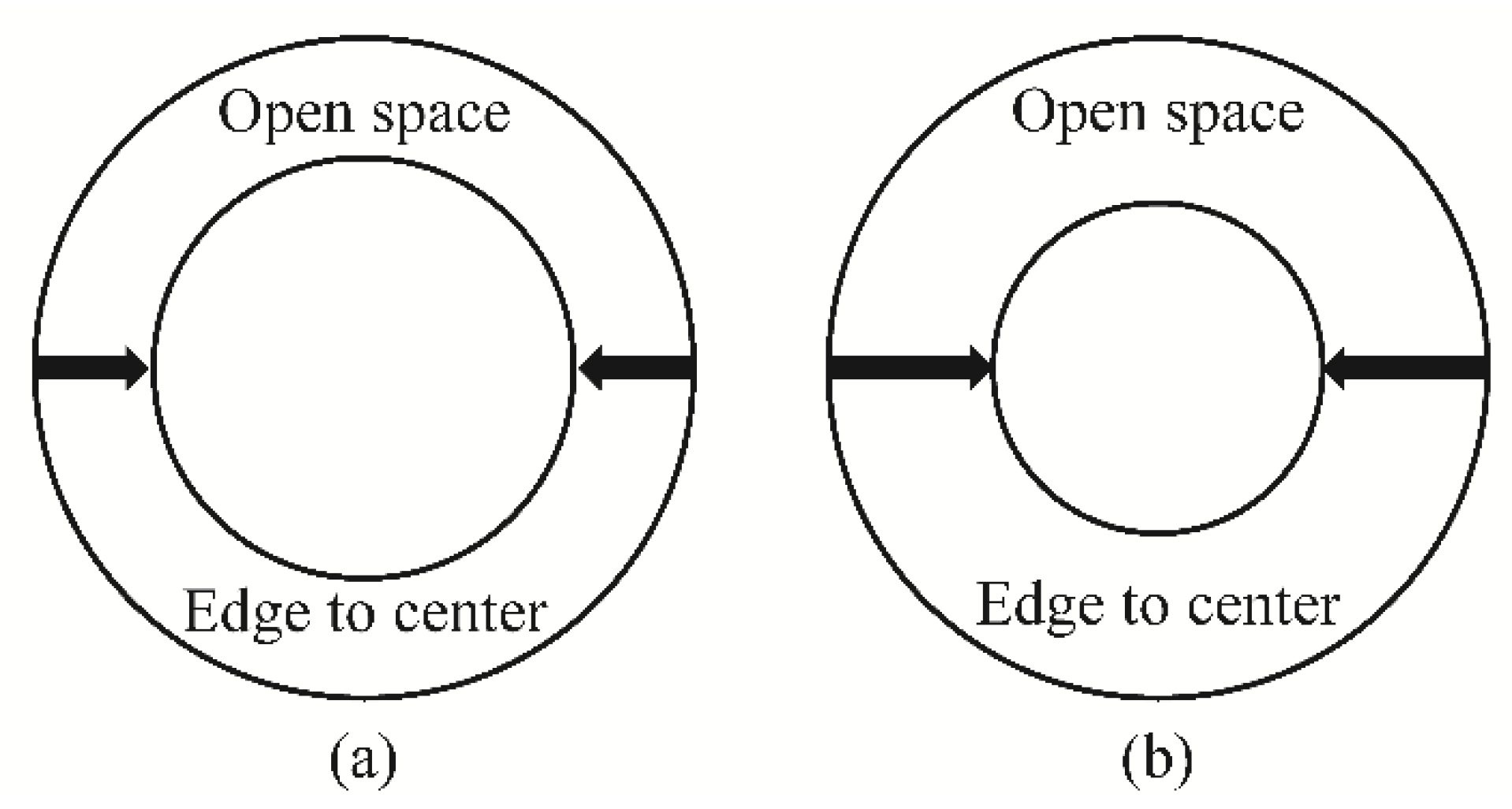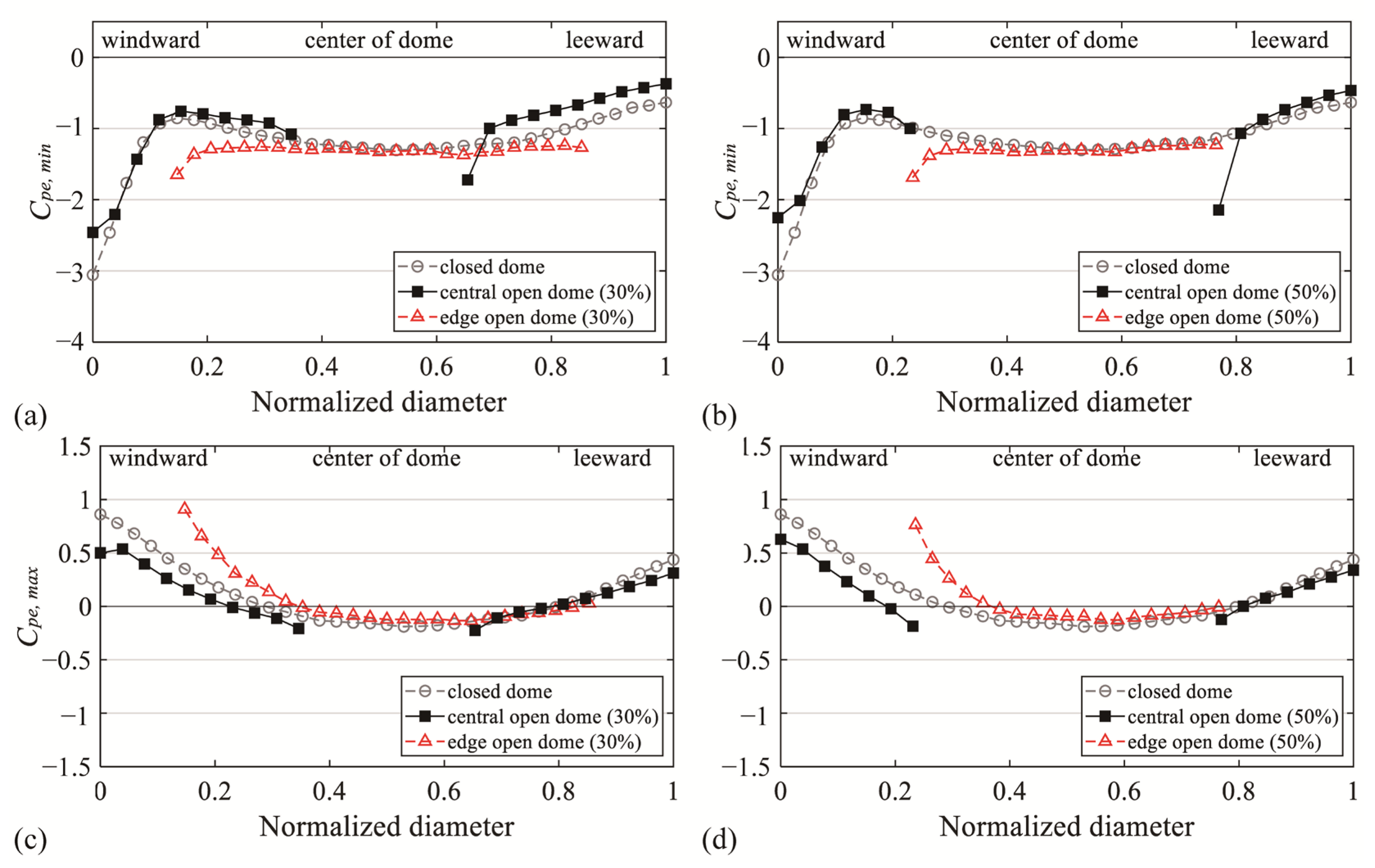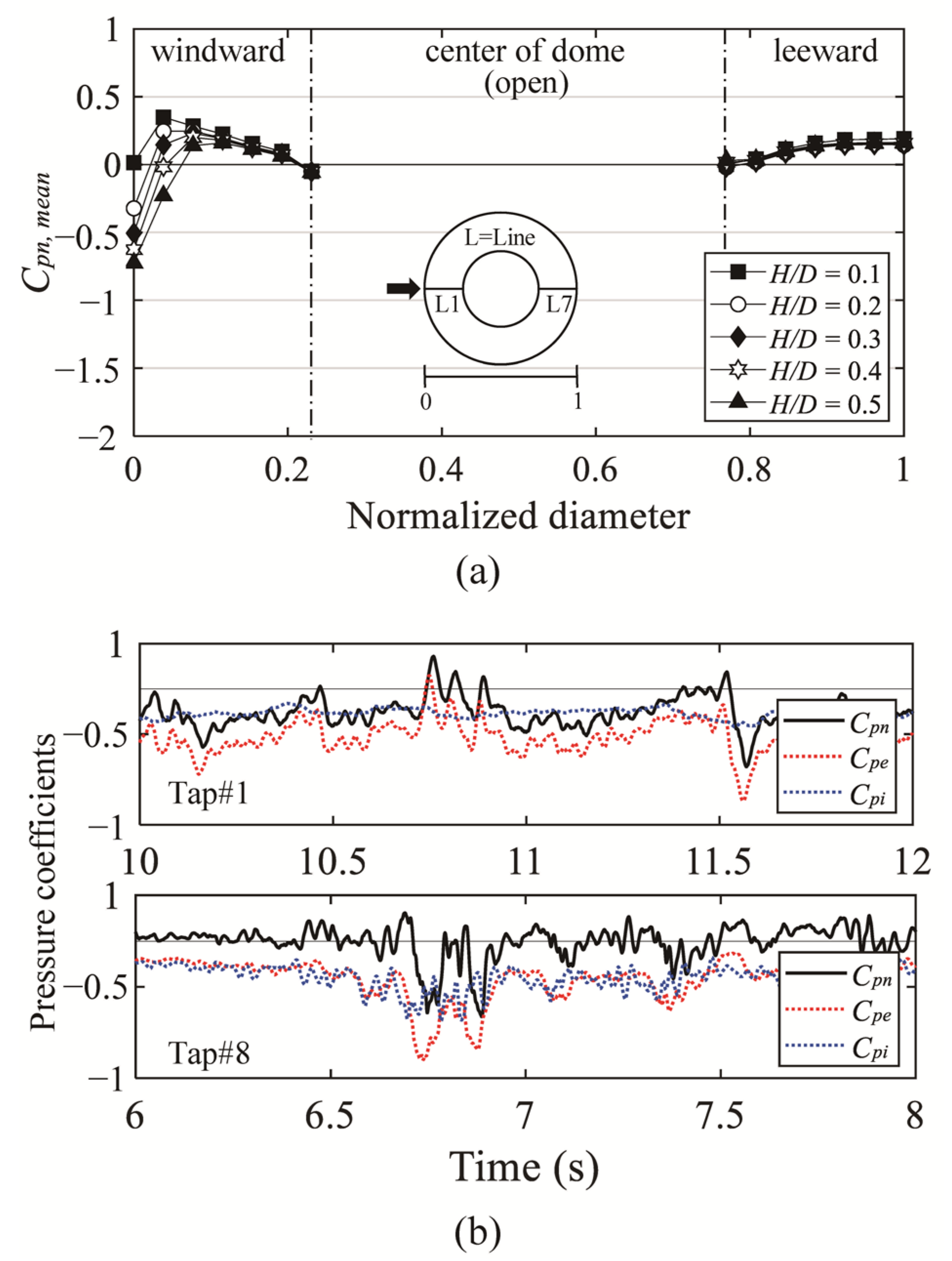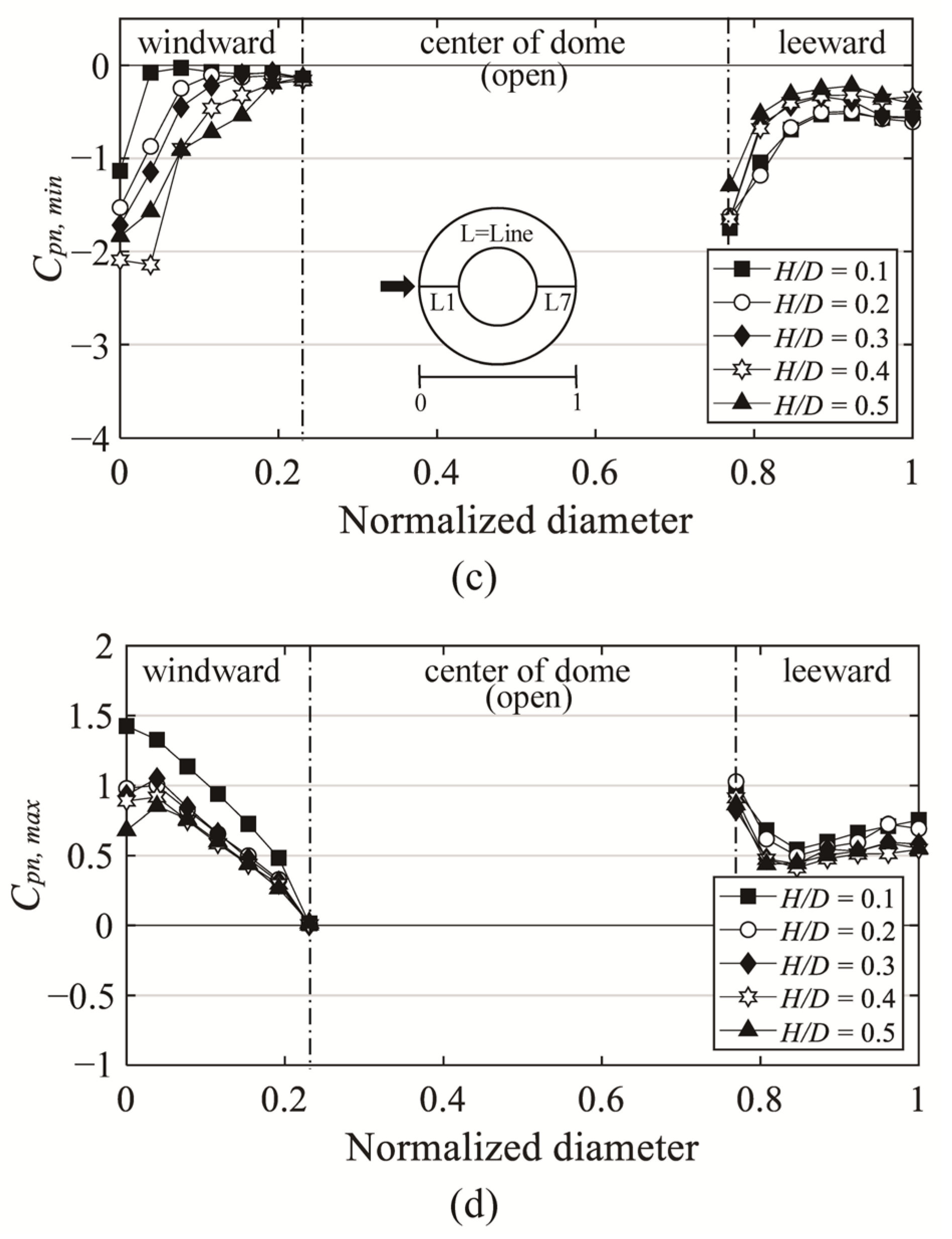The analysis was conducted based on lines 1 and 7 of the centerline showing distinct changes. Line 1 was defined as windward, and line 7 was defined as leeward. The magnitude of the wind pressure coefficient was expressed in absolute values. Furthermore, because the open ratios of 30% and 50% were similar, the analysis was mainly conducted based on the latter value.
3.1. External and Internal Pressure Distribution on the Roof Surface
Figure 5a,b shows the mean and fluctuating pressure coefficients (
Cpe,mean and
Cpe,rms) for all
H/
D values with an open ratio of 50%. The x-axis represents the diameter normalized with the dome span length
D and the pressure tap distance. Here, “0” indicates the edge of the windward roof, “1” denotes the edge of the leeward roof, and the y-axis represents the respective pressure coefficient. As the flow moved toward the leeward side, various changes occurred because of the separation, reattachment, and the boundary layer of the dome surface. As seen in
Figure 5a, the absolute value of
Cpe,mean changes rapidly due to separation when the normalized diameter of the windward region is approximately 0–0.15. The decreasing absolute values started to increase again at a normalized diameter of 0.04 (Tap #2) for
H/
D = 0.1 and at 0.15 (Tap #5) for
H/
D = 0.5. This is because with the impact of the boundary layer formed on the dome surface, reattachment occurred again around the applicable positions. Compared with those of the taps at a normalized diameter of 0.23, the absolute values increased at a normalized diameter of 0.77, which corresponds to the roof edge of the open space, because the flow that deviated from the windward roof surface was separated at the corresponding location. After separation, the absolute value gradually decreased. The flow is assumed to not be along the dome roof surface, because reattachment does not occur, owing to the separation and shape of the roof. This phenomenon can also be observed in
Cpe,rms.
Figure 5b shows
Cpe,rms; the absolute values are larger than those in the other regions at the normalized diameters of 0–0.15 for the windward side and 0.77 for the roof edge of the open space, owing to the effect of separation. For comparison, the dotted lines in
Figure 5a,b represent
Cpe,mean and
Cpe,rms of
H/
D = 0.5 for a closed dome roof. The values and trends of the normalized diameters of 0–0.15 closely resemble those of the central open dome. However, in the region after reattachment, no notable change is observed compared with the central open dome.
Figure 5c,d show the mean and fluctuating pressure coefficients (
Cpi,mean and
Cpi,rms) for the internal roof surface. The increase in the absolute values of
Cpi,mean and
Cpi,rms at the normalized diameter of 0.77 (i.e., roof edge of open space) is assumed to be caused by the separation of the same deviated flow as that in the external roof surface. The absolute values of all other regions were similar.
Figure 6a shows the cross-correlation coefficients for
H/
D = 0.1, 0.3, and 0.5, calculated based on Tap #1 located at the roof edge on the windward side with an open ratio of 50%. In the analysis, the reference pressure tap, Tap #1, was affected by the direct turbulence of the oncoming flows and separation. This pattern reflects the results of previous studies on closed domes with the same or similar
f/
D values [
4,
6,
16]. Based on
H/
D = 0.5, the correlation coefficient rapidly decreased at Tap #2 and Tap #3. This was because as the flow moved leeward, the direct effect of the oncoming flow decreased, and the effect of the vortices owing to separation increased. The cross-correlation coefficient at Tap #4 and Tap #5 rapidly increased because with the movement in the flow, the space containing vortices gradually shrank owing to the roof shape and the effect of reattachment. The correlation coefficient of Tap #6 was similar to that of Tap #5 because this region was after the reattachment. The correlation coefficient decreased again because of the impact of boundary layer on the dome roof surface. From these results, with
H/
D = 0.5, reattachment occurs around the Tap #5 region, which is similar to the reattachment region defined in the mean and fluctuating pressure coefficients in
Figure 5. In addition, the leeward correlation coefficient was independent of the windward correlation coefficient, although it was still affected by separation. This is believed to be because the leeward region was subjected to the effect of separation without the direct impact of the oncoming flows, compared with the case of windward flows.
Figure 6b shows the cross-correlation coefficients of the interior roof surface, calculated based on Tap #15 located at the roof edge on the windward side. The windward region, being unaffected by the flow, has the same correlation coefficient at all areas, as shown by
Cpe,mean. By contrast, the leeward side has no relation with the windward side, similar to that in
Figure 6a; this is because the internal roof is also affected by the separation of the deviated flow.
Figure 7 and
Figure 8 show histograms of the probability distributions for some windward and leeward external and internal pressure taps, and the time series of the pressure coefficients. Here,
H/
D = 0.5, which has the largest absolute value, was used as a representative case. The time series of the pressure coefficients was obtained by selecting one random sample from among 10 samples. In the histogram, the x-axis represents the normalized pressure coefficient; the Gaussian distributions are shown to compare the characteristics of the probability distribution. In addition, the mean (dotted line), skewness and kurtosis values are expressed in the pressure coefficient time series. In general, in the area affected by separation, the roof pressure coefficients exhibit non-Gaussian characteristics with absolute values of the skewness and kurtosis of 0.5 and 3.5 or greater, respectively [
17,
18,
19].
The histogram of Tap #1 in
Figure 7 exhibits a shape similar to that of the Gaussian distribution; in addition, in the time histories, the mean value is larger than that of the other taps. However, the time history plot has a symmetrical shape around the mean value; this is because of the direct effect of the oncoming flows and the effect of separation, as described above. For Tap #3, the absolute values of skewness and kurtosis increase sharply compared with those of Tap #1. Accordingly, the histogram exhibits clear non-Gaussian characteristics, and the time series shows intermittent and distinct negative spikes. This phenomenon occurs because the direct impact of the oncoming flows decreases as the flow moves leeward, as described above. Tap #5 corresponds to the regions of reattachment; after reattachment, Gaussian characteristics are observed, with increasing absolute values of the pressure coefficients. Tap #8 exhibits clearer non-Gaussian characteristics than those of the tap affected by windward separation. Additionally, in the time series, the mean value of the pressure coefficients is slightly smaller than that of Tap #1; however, there is no effect of positive pressure, and the frequency and intensity of the negative spikes are larger than those of Tap #1. The absolute values of the pressure coefficients at the pressure taps after Tap #8 decrease gradually, exhibiting Gaussian characteristics. However, the absolute values are smaller than those of the tap in the windward reattachment region. This phenomenon also arises because reattachment does not occur, owing to the separation effect and shape of the roof, resulting in the absence of flow along the dome roof surface, as explained earlier.
Figure 8 shows the histogram and time series of the internal pressure taps. For the windward region, Gaussian characteristics are observed without any special features, and the histogram, mean, skewness and kurtosis are all similar. By contrast, Tap #22 exhibits non-Gaussian characteristics similar to Tap #8 in
Figure 7; in other words, it is affected by the same separation as that in the external surface of the roof. Tap #23 and 27 exhibit Gaussian characteristics with a decreased pressure coefficient, similar to that in the case of external surface of roof. However, compared with the case of external surface, the absolute value of mean is slightly larger—this is because reattachment occurs due to the shape of the roof and is affected by the boundary layer on the dome surface.
3.2. Negative External Peak pressure Coefficients on the Roof Surface
Figure 9 shows the negative external peak pressure coefficient (
Cpe,min), with the x-axis denoting the normalized diameter and the y-axis denoting
Cpe,min. Notably, the absolute values for all
H/
D values are similar regardless of changes in
H/
D in the region where the separation of deviated flow occurs, unlike in the windward region where the absolute values increase with
H/
D.
Cpe,min ranges from −1.3 to −2.3 on the windward region; on the leeward region, it ranges from −1.6 to −1.8 and −2.1 to −2.3 at the open ratios of 30% and 50%, respectively. This occurs because the flow characteristics became similar, owing to the impact of the boundary layer formed on the dome roof surface after reattachment.
Figure 10 shows
Cpe,min according to changes in
H/
D and the turbulence intensity in two taps affected by separation. The x-axis expresses the
H/
D and turbulence intensity values for each
H/
D. In the figure,
Cpe,min is plotted for each of the 10 samples corresponding to the actual time of 10 min, and the dotted line represents the mean of 10
Cpe,min values for each open ratio. For the windward tap, the data for the closed dome roof are also shown. As the turbulence intensity decreases, flow separation increases [
3]. Thus, a decrease in turbulence intensity (increase in
H/
D) on the dome roof increases the reattachment distance. Further, as the size of the vortices generated by separation increases, the absolute values increase (
Figure 10a). As
H/
D increases, the turbulence intensity decreases, and the absolute values increase accordingly. However, the
Cpe,min values at the roof edge tap in the open space are similar (
Figure 10b). Therefore, the flow becomes constant, irrespective of changes in
H/
D. The absolute values of the open ratio of 50% are larger than those of 30%. This is presumably because the region affected by the boundary layer shrinks and the amount of incoming air increases as the open ratio increases.
Figure 11 shows the distribution of
Cpe,min on the external surface of the central open-dome roof as a contour. In the roof with an open ratio of 50%, compared to the roof with an open ratio of 30%, the region affected by the separation of the deviated flow is more widely distributed. Thus, the absolute values are also larger. All other regions showed similar absolute values.
3.6. Comparison with AIJ-RLB (2015)
In terms of closed dome roofs, the Japanese wind load code (AIJ-RLB (2015)) has more detailed values than other wind load codes.
Table 3,
Table 4 and
Table 5 list the peak pressure coefficients for the external cladding for the dome roofs of the ASCE7-16 code in the United States and the AIJ-RLB (2015) code in Japan. For ASCE7-16, the peak pressure coefficients for each degree are presented. No peak pressure coefficient was applicable to dome roofs with
f/
D = 0.2 or less. On the contrary, AIJ-RLB (2015) presents wind pressure coefficients in detail in three areas for various
f/
D and
H/
D. Therefore, the AIJ-RLB (2015) code was used to compare the experimental values.
The Japanese wind load codes are based on the wind tunnel test results from Noguchi and Uematsu [
2], and their experimental conditions are listed in
Table 6. For comparison, the experimental conditions of the present study are also listed in the table.
The Japanese wind load code classifies the dome roof surface into three regions, Ra, Rb, and Rc, considering the change in wind pressure due to separation and provides the values of the external peak pressure coefficient for each classified region. The Ra and Rb regions are defined as D/8, and the Rc region is defined as D/2.
Figure 17 shows the results of the comparison of the external peak pressure coefficients. The dotted line in the graph indicates the external peak pressure coefficient for each region of the code, and the markers represent the experimental values for all wind pressure taps with open ratios of 30% and 50% and an
H/
D value of 0.3, similar to the code. For
Cpe,min in
Figure 17a, the experimental values in the
Ra and
Rb regions show a significant difference from the code values. As listed in
Table 7, this result is because of the differences in the oncoming flow and model dimensions [
20]. Conversely, the experimental values exceed the code values in the region (
Rb and
Rc) where the absolute values increase, owing to the separation of the deviated flow. For
Cpe,max in
Figure 17b, unlike
Cpe,min, the code and experimental values do not show any notable difference, and the experimental values satisfy the code values.
Figure 18 compares the internal peak pressure coefficients of the experiment and the internal pressure coefficient of the code. For the internal pressure coefficient of the code, based on the closed dome roof, a value of zero is suggested for cases with no openings in the wall, and −0.5 is suggested for cases with openings in the wall. Thus, the comparison was made only for
Cpi,min. Based on the comparison, the experimental values were larger than those of the code in all regions, and a difference of up to 3.8 times was shown in the region affected by separation.
The wind loads for the cladding design prescribed by AIJ-RLB (2015) are calculated by the following equation [
22]:
where
Wc is the wind load,
qH is the design velocity pressure,
Cc is defined as the difference between the external and internal pressure coefficients (
Cpe,peak—
Cpi),
Ac is the subject area of cladding. For the wind loads of the cladding design, two different cases should be considered: (1) a negative pressure on the external roof surface and a positive pressure on the internal roof surface; and (2) a positive pressure on the external roof surface and a negative pressure on the internal roof surface.
The net pressure coefficient—the difference between the external and internal pressures of the central open dome roof—was calculated for comparison. The net pressure coefficients (
Cpn,i) are defined as:
where
Cpe,i and
Cpi,i are the pressures coefficients calculated by Equation (1) at each pressure tap installed in the same line and location on the external and internal roof surfaces.
The mean net pressure coefficients (Cpn,mean) were calculated using Equations (6), and the peak net pressure coefficients (Cpn,min and Cpn,max) were defined as the minimum and maximum values for each Cpn,i.
Figure 19a shows mean net pressure coefficients (
Cpn,mean) for an open ratio of 50%.
Cpn,mean decrease negative pressure and increase positive pressure compared to
Cpe,mean, due to the simultaneous contribution of pressure on the external and internal surfaces of the roof. The internal surface of the roof is only affected by negative pressure. Thus, the negative pressures at the location affected by the separation and boundary layers of the dome surface in the windward region are reduced. Since the wind pressure inside the roof is similar regardless of
H/
D, the
Cpn,mean changes depending on the
Cpe,mean, which is affected by the characteristics of the oncoming flow. However, the
Cpn,mean of leeward side are similar in absolute values regardless of
H/
D and are close to zero. This is because the external and internal pressures are similar.
Figure 19b shows a time series of pressure coefficients. As can be seen from the time series in Tap#1, the
Cpi on the windward side are constant, and
Cpn are affected by
Cpe. However, the leeward side Tap#8 shows very similar
Cpe and
Cpi.
Figure 19c and d shows the
Cpn,min and
Cpn,max for an open ratio of 50%. The absolute values of the windward side are varied depending on the
H/
D, but the leeward side shows very similar absolute values. Compared to the external peak pressure coefficients (
Cpe,min and
Cpe,max), the absolute values of
Cpn,min decreased in all areas, but
Cpn,max increased. The greatest increase can be seen especially at the edge of the roof in the open space (see
Figure 12).
Figure 20 shows a comparison between the experimental value of the peak net pressure coefficient and the code.
Figure 20a shows the case with negative pressure on the external surface and positive pressure on the internal surface (Case 1). The experimental values satisfy the code values owing to the overall reduction in the negative pressure by the large effect of negative pressure on the interior surface. The case where there is positive pressure on the external surface and negative pressure on the internal surface (Case 2) is shown in
Figure 20b. In contrast to Case 1, the experimental values exceed the code values in all areas. For a clearer comparison, the code and experimental values for each area are summarized in
Table 7,
Table 8,
Table 9 and
Table 10.
Table 7 and
Table 8 list the maximum values of the code and experimental values (
Cpn,min) for each area with an open ratio of 30% and 50%. As described above, both open ratios satisfied the codes.
Table 9 and
Table 10 compare the code and the experimental values (
Cpn,max), and both open ratios exceed the codes at the roof edge of the open space. These results indicate that for domes with central openings, wind loads based on the current code may be underestimated or overestimated.
Table 7.
Comparison of code value according to code area and
Cpn,min of open ratio = 30% [
22].
Table 7.
Comparison of code value according to code area and
Cpn,min of open ratio = 30% [
22].
| H/D | Code Value (H/D = 0.25) | Experimental Value |
|---|
| Ra | Rb | Rc | Ra | Rb | Rc |
|---|
| 0.2 | −4.2 | −2.2 | −1.4 | −1.6 | −0.2 | −0.9 |
| 0.3 | −1.9 | −0.4 | −0.9 |
3.7. Proposal of Peak Net Pressure Coefficients for the Central Open Dome
As seen previously, relatively large changes were found in the peak pressure coefficients on the domes with an opening in the center. When comparing the experimental values and code values, the experimental values exceeded the code values in some regions. Considering those findings, the roof was divided into two zones—
Ra and
Rb—and peak net pressure coefficients for cladding design were proposed for each zone. The proposed values selected the largest absolute value that appears in each zone.
Ra covered the area along the roof edge where large absolute values due to separation of oncoming flow were shown, and
Rb covered the area where the absolute values were large due to the separation of the flow deviated from the windward side. To determine a suitable boundary between
Ra and
Rb, changes in the peak net pressure coefficients were carefully investigated for all
H/
D. The boundaries of the two zones were determined by the location where absolute values appear smallest without being affected by separation. Thus,
Ra was defined as 60% of the radius of the roof from the roof edge, while
Rb was defined as the remaining area. This can be seen in
Figure 21.
Figure 21 shows
Cpn,min and
Cpn,max, which shows the proposed values in the
Rb and the experimental values of all pressure taps by
H/
D. The x-axis shows the normalized radius defined based on the radius of the dome (except for the open area) and the distance of the pressure taps, “1” indicate the edge of the roof. The dotted lines indicate the proposed values, which are based on the largest absolute values in the applicable region, and the markers indicate the experimental values. With reference to the region affected by separation of the deviated flow, the absolute values are similar irrespective of the
H/
D change. Therefore, the
Rb region was proposed as a single value. For
Cpn,min, a value of −1.0 was proposed for the open ratio of 30%, and for the open ratio of 50%, a value of −1.8 was proposed. In addition, for
Cpn,max, values of 0.9 and 1.1 were proposed for the open ratio of 30% and 50%, respectively. The values of the Ra region are different according to
H/
D, so it is not expressed in the graph. proposed values are listed in
Table 11 and
Table 12. (Refer to
Figure 1 for region division.)

